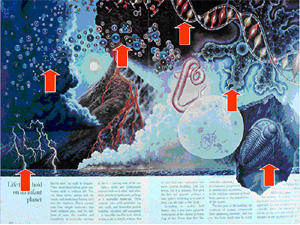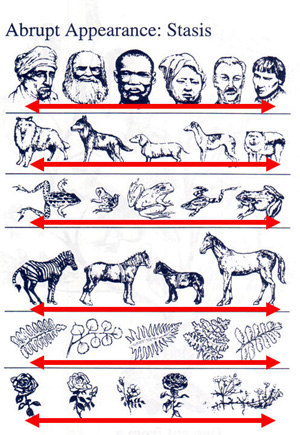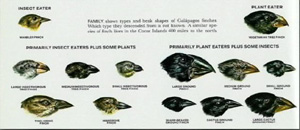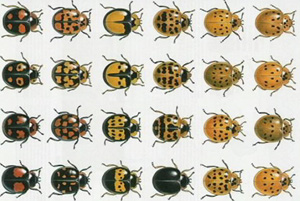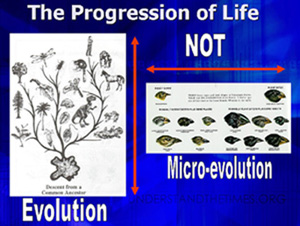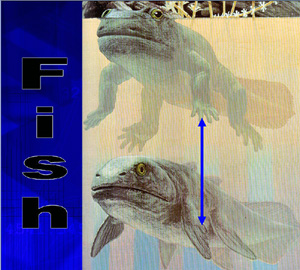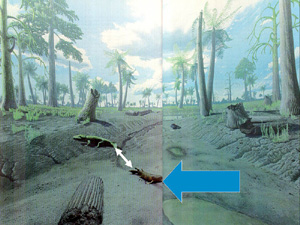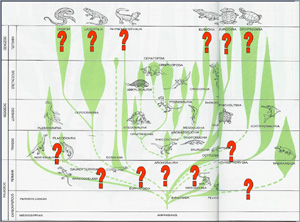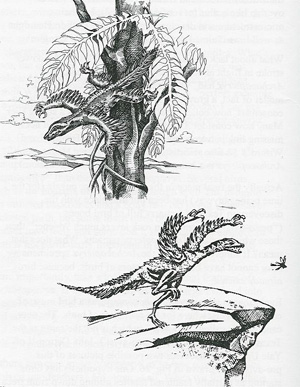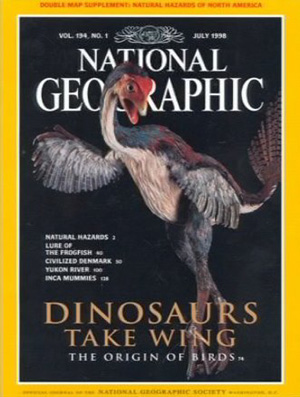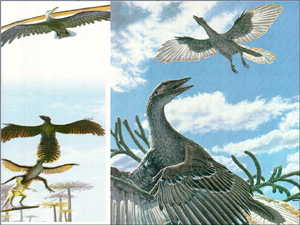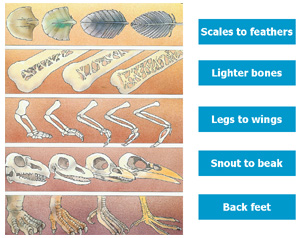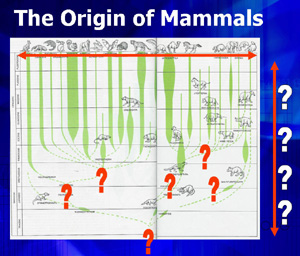We begin now with the third session of our seminar entitled, Searching for the Truth on Origins. We will continue to look at the facts regarding the Creation—evolution controversy. The title of our topic in this particular session is called, "The Origin and the Progression of Life."
As with the origin of the universe, we really have two choices regarding the origin of our planet Earth. Either life originated by process of chance or it came into existence because of a supernatural Creator-Designer. In our last session we looked at this subject of why the universe exists—why the solar system and our planet exists. Now we want to get down to the basic point regarding the Creation-evolution controversy and that is: How did life come into existence on this planet?
Again we turn to some of the statements made by individuals who claim that evolution is the only credible worldview. They claim that science has proven that life has originated not because of a Designer-Creator, but because of a natural process. We can quote Isaac Asimov for example, a former promoter of evolution who is now deceased. Asimov has made this statement in the past regarding the origin of life:
We can make inspired guesses, but we don't know for certain what physical and chemical properties of the planet's crust, its ocean, and its atmosphere made it so conducive to such a sudden appearance of life. Nor are we certain about the amounts and the forms of energy that permeated the environment in the planet's early days. Thus the problem that scientists face is how to explain the suddenness with which life appeared on Planet Earth. (Asimov, 58)
Now this is a rather significant statement. Asimov was willing to admit that the best that we could do regarding the subject of the origin of life is to make inspired guesses. But as we mentioned in our previous presentations, science must be based on fact, observable evidence, and repeatable experimentation. Certainly there must be more than this in order to verify the idea that life has evolved.
Regarding the origin of life, John Reader, evolutionist and scientist, from the book The Rise of Life, makes this statement:
Once life began, its story becomes a logical (not to say inevitable) sequence of evolutionary cause and effect which science is able to recount in fascinating detail. But just how life began is still something of a mystery. Not incontrovertibly explained. The chemical constituents of organisms have been identified. The biochemical processes that keep organisms alive are known in complex detail, but the vital spark that initiates life awaits precise definition. Life: so obvious and simple a phenomenon, yet so hard to explain. (Reader, 9)
Well that is another interesting statement made by a scientist who is an evolutionist. And as you can see, there is no proof that life has originated from non-life by chance.
Then we could look at another statement by Raymond Hawkey, a scientist who is an evolutionist, in his book, Evolution: The Story of the Origins of Humankind (page 1). Regarding the origin of life, he states:
After countless chance encounters between organic molecules, an event as miraculous as that which created the universe occurred in the depths of the seas. About 3,500 million years ago groups of organic molecules came together to form living cells which all life was ultimately to descend. (Hawkey, 1)
So as we can see from these three statements, there is one common denominator and that is that the evolutionary worldview is based on the assumption that in the distant, unobservable past, non-life became life-spontaneously, without a designer and without a creator.
All of us, at one time or another, have seen typical charts like this one taken from a National Geographic. It is showing how life takes hold of an infant planet and there on this mural we see the sequence. On the bottom left-hand corner, we see lightening bolts striking the primitive pond. Then above that we see the appearance of atoms forming molecules; then these molecules become more complex and we see the appearance of a cell, and then we see a multi-cellular creature. There is the sequence. That is how they say it happened, but is this chart proof?
A number of years ago (in the late 1980s) I had an opportunity to be involved in a documentary film called, The Evolution Conspiracy. We traveled around North America, in Canada and the United States, to major museums and universities. We interviewed curators of museums and professors asking them why they believed that evolution was true. One of the locations we went was the Smithsonian Institute in Washington D.C. And when we were interviewing the curator of the non-life to life portion of the museum, he was standing in front of a mural very much like the one above. We asked him this simple question: "How did life originate?" He attempted to answer, in fact, three times he attempted to answer and each time he stuttered and stammered. Finally after the third attempt, he stopped and said, "You know, I just can't formulate the words in order to make a proper presentation." He said,"You'll have to find somebody else to do this." He refused to continue and we were unable to use anything that he had said. He would not even sign the release.
Then as we were taking down the camera equipment, the curator of the Smithsonian Institute walked over to the cameraman and he started to chuckle. He said, "You know, I'm almost embarrassed but I realized as I was attempting to answer this question that the whole idea of the origin of life is so speculative. I certainly don't want to be in this film representing the evolutionary position."
Now that is amazing because over six million students are bused to the Smithsonian every year and they see the same presentation. In fact, there is a little theater there called the Chon-Chon Theater. Carbon, hydrogen, oxygen and nitrogen are cartoon characters and they do a little dance and join hands together in a film. Poof! All of a sudden they become a cell! But cartoons and paintings do not prove that non-life can become life. No one has ever observed it.
You see a number of years ago, Immanuel Reddy proved to the world that you cannot get life from non-life spontaneously. At that time people believed that if you put garbage outdoors it would eventually turn into maggots and flies and rats. And so, he placed garbage outdoors, covered it over with a screen, and of course the flies and the rats were not able to get to the garbage. And he verified that it is not possible for non-life to become life. Well, the evolutionary assumption is that it did happen a long time ago in the distant, unobservable past.
The idea that non-living materials can assemble to become life has been accepted by the intellectual community that support evolution. And of course, one of the experiments that is commonly referred to is the Stanley Miller experiment. It goes back to the 1950s. Many people today still argue, "Well you know, it's possible in a laboratory, given the right conditions, to produce building blocks of life."
And this is what Miller did. He had an apparatus which included boiling water. He created an oxygen-free environment; methane was added, hydrogen was added, ammonium hydroxide, and then a 50,000 volt spark. There was a cooling chamber and a trap, and yes, he was able to produce some building blocks—amino acids, glycine, alanine, aspartic and glutamic acid. There were non-biological amino acids—urea, organic acids, formic, acetic, succinic, and lactic.
But, there were problems. You see, this was an oxygen-free environment and that would have been totally unrealistic in the original earth if life originated from non-life. And of course, there would be no trap present when life was formed. There was a production of these toxic chemicals which would have destroyed any of these building blocks that were supposedly created spontaneously. Left-handed amino acids are the only ones that are required for life—-when in this particular situation, both left-handed and right-handed amino acids were produced. Today most scientists do not refer to Miller's experiment as verification of the proof that non-life can become life.
For example, an article entitled "A Calculation of the Probability of Spontaneous Biogenesis by Information Theory," from the Journal of Theoretical Biology, volume 67, page 396, Hubert Yockey states the following:
The warm little pond scenario was invented ad hoc to serve as a materialistic, reductionist explanation of the origin of life. It is unsupported by any other evidence and it will remain ad hoc until such evidence is found. One must conclude that contrary to the established and current wisdom, a scenario describing the genesis of life on earth by chance and natural causes, which can be accepted on the basis of fact and not faith, has not yet been written.(Yockey, 396)
It could not be clearer. In other words, what Yockey is saying, is that it has never been observed that non-living materials can spontaneously formulate life.
Nevertheless, we continue to see this propaganda proclaimed. For example, in National Geographic, March 1998, page 60, there is an article about Stanley Miller's experiment (father of pre-biotic chemistry) and this statement:
Approximating condition on the early earth, in a 1952 experiment Stanley Miller, now at the University of California at San Diego, produced amino acids. "Once you get the equipment together it's very simple," he says.(Monastersky, 60)
Well, what are they talking about? A building block. They are talking about an amino acid, which is a component of a protein. Now, scientists have attempted to look at the possibility of proteins formulating spontaneously from amino acids at the Massachusetts Institute of Technology and through statistical analysis they came to the conclusion that the possibility of a protein molecule being formulated by chance would be one over ten followed by fifty-six zeros. Now that is an extremely small possibility. How small? Well, this is the analogy which they gave. They said it would be like walking down the street one day and seeing a lottery ticket on the sidewalk, picking up the lottery ticket and discovering that you had won the lottery for that week! But you would also have to do it the second week in a row, and the third week in a row. You would also have to find a winning lottery ticket the fourth week in a row, the fifth week in a row—in fact, every week in a row continuously for one thousand years. That is the possibility of a protein molecule coming into existence by chance.
A protein molecule is a building block of a cell. You see there is not a chance that it could have happened. This idea that molecules can become cells is nothing more than science fiction. There are no facts to support it.
Another fact of biology is that life must come from pre-existing life. It is called the law of biology. When I was a student and when I taught biology, we taught this law. No one has ever observed life coming from non-life. But the evolutionary assumption is that it had to have happened in the past. All life that we have ever observed comes from life which already exists. Nobody has ever seen anything different. Dogs have puppies, cats have kittens, and that is how life perpetuates.
HORIZONTAL GENETIC VARIATION
Now there is another important principle that we can observe—that is within the lifecycles of the things which we see. We see what we call "kinds of life" that show the appearance of variation—variation which occurs within genetic boundaries, horizontally. And a good example would be the dog kind. There are many different varieties of dogs but they are all dogs—from Chihuahua to Saint Bernard. Now if evolution is true, we should find some sequence showing something becoming a dog and a dog changing to become something else. That is not the case. We see variation within genetic boundaries and that variation is horizontal, not vertical.
For example, this chart taken from John Morris's book, The Young Earth, shows the variation within the humankind. There are over six billion of us and we all are different, but we are all humans. There are variations within the dog kind, the frog kind, the horse kind, and of course, various kinds of plants. That is what we can observe.
And by the way, that is what Charles Darwin observed. You see, evolution is based upon one important fact and that is the idea that through time there are changes that do occur. But these changes, as we observe, are horizontal. Charles Darwin (often called the father of evolution) was one of the individuals who contributed to this concept. In some of our later seminars we will present other founding fathers of the evolutionary idea.
But Darwin observed, in the Galapagos Islands, variation within genetic boundaries. He saw that there were numbers of different kinds of finches with different beaks—some short, some long, some medium. And he said, "Look at this, there is a variation of beaks within the finches." So this was the basis of his whole theory that through time, gradual change occurs. Well that does happen, but as we are going to see, the gradual change that occurs is horizontal.
BEETLES ARE BEETLES
Now there is a picture of Charles Darwin in the Darwin Museum in Moscow. In the introduction it was mentioned that I have had the opportunity to travel in Russia and various places to speak with various groups of scientists and educators. As you can understand, for many years the former Soviet Union was based on an atheistic worldview, which was based on Darwinism. The whole concept of evolution was foundational to that atheistic belief. Here in the Darwin Museum I will show you one of the examples that presented to show that evolution is true. There we have a series of beetles with different color variations. And they say this shows that change can occur gradually through time. Well yes, but these beetles are beetles. They remain beetles. They do not change to become something else. And that is exactly what we would expect from the biblical Creation view.
THE PEPPERED MOTH
Now another argument for evolution is the existence of the peppered moth. We will just go through this briefly. Before the Industrial Revolution in Great Britain there were two kinds of moths, a dark variety and a light variety. During the revolution when coal was burned and there was a lot of pollution, the bark of the trees darkened and as a result the light variety was easily seen—this is the theory. Then the dark variety increased in population because it was protected by the environment. Following the Industrial Revolution, when the pollution was cleaned up, then the lighter varieties supposedly increased. And so what does this show us?
First of all, there is research that has been done recently suggesting that some of the data that was collected to try to prove the peppered moth theory was somewhat tainted. But nevertheless, whatever the case, this is the argument: Before the Industrial Revolution there were two varieties of the peppered moth, dark and light. Following the Industrial Revolution and the cleaning up of the pollution there were two varieties, dark and light. And one kind did not change into another. The population changed but we do not see a change taking place from one kind to another. So this whole idea has been used really as some of the basis of the evolutionary assumption.
Creationists believe that natural selection occurs and that in fact, it is a fact of nature. But natural selection does not change one kind of life into another. It only preserves the best that is suited. The environment provides the factors that assist in selecting out the best suited for life so that the perpetuation of life may occur rather than become extinct.
THE DARWINIAN TREE OF LIFE
You see when it comes to this idea of the progression of life, the evolutionary assumption is that given time, once non-life evolved into the mother cell, that this cell then progressed and developed and became the mother of all life forms of the Darwinian tree of life. And so, at the bottom of the chart we see an amoeba. At the top of the chart we see a man. And the belief is that over hundreds of millions of years of time, as these layers were supposedly laid down, life lived and died and the progression occurred from simple to complex. And that is how we should find it in these geological layers. So as you can see there is a vertical progression from the bottom to the top, from simple to complex. This is what the evolutionary assumption teaches.
And here is the typical Darwinian tree of life showing the amoeba at the bottom and the man at the top. But is this what Darwin observed? Absolutely not! What Darwin observed is change or variation that took place horizontally. And many people call this kind of change micro-evolution. But as you can see, we are talking about two different things. The variation of life that occurs horizontally does not verify the idea that life changed vertically from simple to complex. And this is what confuses many people. They say, "Well I know evolution takes place because life changes." It changes horizontally within genetic boundaries.
SINGLE TO MULTI-CELL
So, now we move on and we look at the next level of the progression of life and that is from cell to multi-cellular. We have already looked at this idea that non-life cannot become life, but what about the suggestion that a cell can become a multi-cellular creature? Well, let us look at what has been proposed.
Here is an example of an article called, "The Cambrian Period and the Explosion of Life," taken from National Geographic, October 1993, page 120. And here you see a couple of individuals and who are in the Canadian Rockies in British Columbia, Canada—near Field, British Columbia. And as you can see they are picking in the rock and what they find there is very interesting. Let me read to you from the article.
More than half a billion years ago, the world's first monster appeared. With bulging eyes and fearsome grasping claws, Anomalocaris cruised the seas during the geological period known as the Cambrian. Its mouth was a nightmare of hard plates and teeth. Its body looking like a cross between a stingray and a lobster. It could grow three feet in length, a giant for its time. For millions of years animals have been simple, mostly anemone like creatures or worms. Then in a geological blink of about ten million years virtually all the phyla or groupings based on body design of animals alive today, came into being. Perhaps encouraged by an increase of oxygen in the seas, this Cambrian explosion was the greatest burst of animal evolution the planet has ever known and new fossil finds are highlighting its detail. (Gore & Mazzatenta, 120)
Well, this is amazing! What are they telling us? They are telling us that at the bottom of the geological chart, the Cambrian layer (one of the oldest supposed layers of earth's history) there is a sudden appearance of complex creatures. Here are some of the examples. You see all of a sudden, multi-cellular creatures appeared and many of these creatures look like something out of science fiction. Some of them have eyes, tentacles, and complex organs. So now we have a great problem because in the Cambrian, which is supposed to be down at the bottom of the chart as one of the oldest layers, we have the appearance of these complex animals. And they have no intermediates that they can trace in order to show that single-cell creatures have evolved.
Richard Dawkins, the evolutionist, promotes evolution in a great way in Great Britain. In his book, The Blind Watchmaker, he has made this statement:
The Cambrian strata of rocks, vintage about 600 million years ago, are the oldest which we find of the major invertebrate groups and we find many of them in advanced state of evolution the very first time they appear. It is as though they were planted there without any evolutionary history. Needless to say this appearance of sudden planting has delighted creationists. (Dawkins, 229)
You see, this is incredible! The facts tell us that in this supposed oldest layer (the oldest layer in earth's history) you have the sudden appearance of multi-cellular organisms and as Dawkins said, "It looks like they have been planted there." And he said, "...to the pleasure of creationists." Why would he say that? Because creationists believe that life came on the scene as a result of a Creator. And as we are going to see later, it was destroyed and that it is not found in the sequential evolutionary pattern. Amazing!
And so that brings us to our second major point. There is no evidence that single-celled organisms have become multi-cellular organisms. There are no facts. These multi-cellular creatures are complex and they suddenly appear.
NO BACKBONES TO BACKBONES
Now let us move on to the next level on the way up the Darwinian tree of life, from multi-cellular creatures without backbones to multi-cellular creatures with backbones. For example —fish. This is another evolutionary assumption but is there any evidence?
Now this is very important. If evolution is true don't you think that there would be countless examples in museums showing this intermediate? You see fish have backbones. We have backbones. So the evolutionary proclamation is that we are related to fish. So certainly, there should be this link between creatures without backbones and those with backbones, so there must be examples in the fossil record that would be on display in the museums.
And now I quote to you from The Fishes by F. D. Ommanney, who states:
How this earliest chordate stock evolved, what stages of development it went through to eventually give rise to truly fish-like creatures, we do not know. Between the Cambrian, when it probably originated and the Ordovician, when the first fossils of animals with really fish-like characteristics appeared, there is a gap of 100 million years which we probably never will be able to fill. (Ommanney, 60)
You see this is not a creationist making this statement. This is someone who is in support of evolution. And he is simply saying this: Between multi-cellular creatures without backbones and multi-cellular creatures with backbones there is a hundred million year gap and there is no evidence. He says we will probably never find the evidence. That is very significant.
So now we have another problem. Not only do we not have any evidence that non-life could become life, there is no evidence that single-cell organisms can become multi-cellular. There is no evidence now that multi-cellular organisms without backbones can become multi-cellular creatures with backbones. So, there is another major problem for the evolutionary worldview. There are no facts.
FISH TO AMPHIBIAN
Moving on now, from fish to amphibian, again this is a major assumption of the evolutionary model and the Darwinian tree of life. The belief is that through time fish have evolved to become amphibious creatures. Well how did that happen? What kind of evidence do we have?
I would like to refer to this book. It is called, The Rise of Life, the First Three and Half Billion Years, by John Reader. This book I obtained at the Smithsonian Institute when we were there doing the documentary film that I mentioned earlier. And in the book there are a number of artists' conceptions. Particularly the ones that I am going to be showing you supposedly demonstrate how fish evolved into amphibian.
And here is the first artist's conception. You will see at the bottom—a fish. And notice what happens as the fish begins to rise up towards the top of the pond. You will notice that the fins change to become legs. Has this been observed? Well again, what we have here is an artist's illustration.
Let us look at another illustration from the same book.
There we see a stream which appears to have dried up. And notice at the bottom of the stream near the edge of the water that remains, there is a fish-like creature with fins. Then notice what you see crawling up the side of the bank—now you have an amphibious creature with legs. So it is amazing what can be done with artists' illustration. But the point that we are trying to make is we need more than artwork in order to verify a theory. We need the fossils. We need facts.
People have said we do have facts—the Coelacanth that was a missing link between fish and amphibian. Well, the Coelacanth is an interesting discovery. You see it was believed to have been extinct for over seventy million years, until in 1938 a Coelacanth was caught alive and well off the coast of Madagascar. Up until that time the Coelacanth had been used in order to try to date layers. And when they found a Coelacanth they knew that the layer had to be at least seventy million years old. It was called an index fossil. So as you can see, this would create a problem. Now they found a living Coelacanth. That means they are still alive. And the Coelacanth was no longer used in order to date the layers of the earth. The Coelacanth was a fish and not a link between fish and amphibian.
R. L. Carroll, again an evolutionist, from Vertebrate Paleontology and Evolution, makes this statement:
No one can be certain which group or groups of fishes was the first to make the transition to land, or what their evolutionary pathways may have been. The transition from water to land occurred long ago and various family trees suggested by the fossil record are so tangled that scientists acknowledge they may never be able to sort them out definitely. (Carroll, 198)
So now we have another problem for the evolutionary worldview. Although the claim is made that fish have evolved to become amphibians, the evidence is very questionable.
AMPHIBIANS TO REPTILES
Now we move on to the next level of this evolutionary idea that life has evolved through time, vertically. It is also believed that amphibians through another channel evolved to become reptiles. But again we need to ask the question, what is the evidence? Well there are numerous kinds of reptiles. We have turtles. We have serpents. There are various kinds of lizards and even flying reptiles. So there is quite a differentiation. And in fact when we talk about the reptilian kind, we see some rather interesting creatures like crocodiles or alligators and it is generally believed that the dinosaurs also fit into this category. So when we look at dinosaurs (one of the most fascinating subjects when it comes to the subject of fossils and the past) we see there are many, many different variations and these creatures grow to tremendous sizes—not all of them but many did. And they are found all over the world. So how did they come into existence? According to evolutionists, it was by a process of gradual change evolving from the amphibians.
Here is a book put out by Scientific American. As you can see the title is called Evolution. And in this book there are a number of charts. I will show you this particular chart which is supposed to show how amphibians evolved into reptilian creatures.
There at the top are the reptilian creatures. At the bottom you see the common ancestor, the amphibian. But now you will note as I put up these question marks at the bottom of the chart, placing the question marks where there are dotted lines. What does that mean? Well, that simply means there are no fossils in order to be able to tie the amphibians to the reptilian creatures at this level. But notice at the top you see the appearance of all of these reptiles. If there is no way to connect the dots, then how can we prove that amphibians have evolved into reptiles? The answer is that we cannot.
In his book Vertebrate Paleontology and Evolution, Carroll (an evolutionist not a creationist) states:
The early amniotes [that is, reptiles] are sufficiently distinct from all Paleozoic amphibians that their specific ancestry has not been established. (Carroll, 198)
Now this creates a further problem. This belief that amphibians evolved to reptiles is not based on observable evidence and yet it continues to be presented.
REPTILES TO BIRDS
Now we move to another phase of the evolutionary tree and that is the belief that reptiles have evolved to become birds. And again we need to ask the question, "Is there evidence that this has occurred?"
Again in the Darwinian tree of life you see on the tips of the branches, various kinds of life have been placed. We have already gone through the lower sequence—the idea that non-life can become life—there is no evidence. The idea that a single cell organism can become a multi-cellular creature—there is no evidence. The idea that a multi-cellular creature without a backbone can become a multi-cellular creature with a backbone, like a fish—there is no evidence. There is the belief that fish have become amphibian or that fish have become reptiles—there is no evidence.
Now we look at this next thing—that is that reptiles evolved into birds. Well, surely there must be evidence! As with these other examples that we have looked at, there are no intermediates. Now think of this. This should be an easy one of which to find an intermediate. If a reptile has evolved into a bird, obviously there are a lot of differences. But let us just look at one difference. Reptiles have legs, front legs. Birds have wings with feathers. So if evolution is true shouldn't there be countless examples showing legs becoming wings? There are none. None have ever been found.
What about Archaeopteryx? This is another example of what they say is a missing link that has been discovered. Well there is a lot of controversy over Archaeopteryx. They say it has reptilian characteristics and bird characteristics. Why do they say that? Well it had teeth in its mouth and claws on its wings. But there are countless birds in the fossil record that have teeth in their mouths and they are birds. There are living birds today that have claws on their wings, and they are birds. So these two features should not verify that Archaeopteryx is part reptile and part bird. Nevertheless the theory continues.
The evolutionists say it must have occurred that reptiles have become birds. And we often find illustrations showing how this occurred.
Here for example, is supposedly proto-Archaeopteryx, which you can see he does not look very confident about flying. Here is another version of Archaeopteryx at a later stage with his wings spread out ready to take off and another illustration with Archaeopteryx in the air.
You see there has been a lot of debate over how birds evolved, and I find this particular debate very interesting. It is from a science yearbook, 1980, but it is still relevant. Let me quote, regarding the debate over bird flight:
Most paleontologists assumed that Archaeopteryx could fly, or at least to glide from tree to tree. They assumed that the bird's ancestors learned to climb trees to escape from predators and seek insect food. Once the bird was in the tree, feathers and wings evolved to aid in gliding from branch to branch. (Unknown)
Paleontologist, John H. Ostrom of Yale University in New Haven, Connecticut, reported in January 1979, however, that:
Archaeopteryx learned to fly from the ground up and not from the trees down. Carnivores ran along the ground chasing flying insects, which they nabbed with their teeth or their front legs. Longer feathers in the front legs evolved to act as an insect net and so the legs became wings. Then they used the wings to make flying leaps after insects. (Ostrom, 292)
Here are two different views!
I like this particular illustration. Dr. Gary Parker, who is a good friend of mine, has an illustration in one of his books outlining these two views.
You see the one idea is that this proto-bird climbed up into the tree and needed to find a way to get down, so it evolved wings to glide from branch to branch. But the other idea is no, it did not happen that way, rather that proto-Archaeopteryx was running along the ground chasing flying insects. And on one occasion perhaps this flying insect was just hanging over the edge of a cliff and Archaeopteryx took a leap after the insect and wings had to evolve. As you can understand, this is ludicrous—there is no evidence that wings have evolved. However, in order for evolution to be true that would have had to have been the case.
Here is the "Dino Bird."
Every once in a while we see discoveries presented in major journals or magazines like National Geographic. Now who could deny this? On the front cover of National Geographic you see a primitive reptilian bird-like creature. Now where was that discovered? Well first of all, let me tell you that that is a model, not a fossil. And the feathers, of course, have been added. The interesting thing about this National Geographic article just a few months later it was discovered that the fossils that were used to formulate this dino-bird were fraudulent. Actually what happened was that they used two separate fossils (a reptile and a bird) and they combined the two. Actually, they found that the fossils were bought from a Chinese farmer and this proved to be somewhat of an embarrassment to those who were involved. What you see on the front of National Geographic is not true.
But, in National Geographic is this presentation.
And you will see in the bottom left-hand corner there is a dinosaur standing on a tree branch. And above that you see one with wings who has already taken off. Again, you can do amazing things with artwork. But this in no way verifies the evolutionary assumptions.
Regarding what would have to occur for reptilian creatures to become birds, by illustration, National Geographic shows us the process that they say occurred.
But think of what would have to happen: scales would have to become feathers; there would have to be the formation of lighter bones for flight; legs would have to become wings; the change from a snout to a beak; and then, of course, the change in the back feet. There are many other changes that would have to occur for reptiles to become birds. You see this creates another problem. And this whole idea that reptiles have evolved into birds, again is based on very questionable evidence. There are no facts.
REPTILES TO MAMMALS
Now we move to this other category and that is the change from reptiles to mammals. Evolutionists believe this has occurred. They say that reptilian creatures through time have become mammalian. Now think of what would have to occur for this to be true. Mammals have hair or fur that would have to evolve from scales. Mammary glands for feeding only appear in mammals. How did that occur? Mammals are warm blooded creatures. They require temperature regulation, increased locomotion, a diaphragm for breathing, and their offspring are born alive. You see, it is easy to make a claim that reptiles evolved to mammals, but can you show the process of how that has occurred? It is impossible and yet it is believed! Finally, a fetal circulation system is necessary which I will discuss in another session.
And back to the chart that we looked at earlier from the same book.
We notice that at the bottom of the chart there is absolutely nothing for a common ancestor. And again, you will see question mark after question mark. That is where the dotted lines are. But at the top of the chart you will note that all of the mammals are shown which are supposedly related to reptiles. Based on what evidence? There is absolutely none!
The horse series you will see in almost every museum. That is this idea that a rabbit-sized creature evolved through time to become the modern horse. I was in the Museum of Natural History in New York City, where they have these elaborate paintings and models showing how the evolutionary process occurred. And very few people will question this because, well, it is in the history museum! Surely they know what they are doing.
Regarding horse evolution, let me quote a statement by Professor G. A. Kerkut from the department of Physiology and Biochemistry at the University of South Hampton. In an article called "Implications of Evolution," he says,
It would not be fitting in discussing the implications of evolution to leave the evolution of the horse out of the discussion. The evolution of the horse provides one of the keystones in teaching evolutionary doctrine, though the actual story depends, to a large extent, upon who is telling it and when this story is being told. In fact, one could easily discuss the evolution of the story of the evolution of the horse. (Kerkut, 144-145)
So as you can see this evolutionist is not convinced.
The idea that reptiles have evolved into mammals, like all of the other examples that we have talked about previously, is not based on any evidence.
APES TO HUMANS
Later in our series we are going to be talking about this through an entire session—that is the idea that apes have evolved into humans. This is perhaps the most commonly taught principle that our ancestors are brute ape-like creatures. And we will point out once again that there is absolutely no evidence to support that principle.
But for now, I want to quote from a book by Richard Leakey, Making of Mankind. As you may know, Richard Leakey has been one of the major promoters of the evolutionary assumption through the years, and particularly in the relationship of apelike creatures evolving into man. From the introduction of Richard Leakey's book he makes this statement:
I express concern about the growing support for creationism because it has serious and far-reaching implications. If society legislates against the teaching of scientific truth on one issue, where will this process stop? A few people still hold to the belief that the earth is flat. Should they too, have equal time in schools? The great achievements of modern science are gravely threatened by this insane development. (Leakey, 2)
Richard Leakey is saying that if you question the evolutionary worldview and you belong to that creationist camp, you are insane. But I think that it can be demonstrated that the assumptions of evolution are without evidence, based on what we have looked at here today. There is no evidence to support:
- The idea that non-life can become life
- The idea that a single cell organism can become a multi-cellular creature
- The idea that a multi-cellular creature without a backbone can become a multi-cellular creature with a backbone
- The idea that fish can become amphibians, or that amphibians can become reptiles, or reptiles can become birds or mammals
So to challenge these things, does that categorize someone as insane? I do not think so. I think that many people have simply accepted what they have been taught and they have not checked it out for themselves.
And as we conclude, I want to refer to the Apostle Paul's warning.
O Timothy, keep that which is committed to thy trust, avoiding profane and vane babblings and oppositions of science, falsely so called, which some professing have erred concerning the faith. Grace be with thee. Amen. (1 Timothy 6:20-21)
You see the creationist view is simple—God created life. And creation came on the scene with all kinds of life, in the beginning in multiplied, perfected forms with the ability to reproduce after its kind. Therefore there will be variation horizontally, but not vertically.
I trust that this presentation will give you a better understanding of why the creationist view is credible.
Bibliography
- Asimov, Isaac. Omni Magazine. November, 1983, pg. 58
- Reader, John. The Rise of Life: The First 3.5 Billion Years. Alfred A. Knopf. 1986, pg. 9
- Hawkey, Raymond. "Evolution: The Story of the Origins of Humankind". Genesis Productions, 1987. pg. 2
- Yockey, Hubert P. Journal of Theoretical Biology. "A Calculation of the Probability of Spontaneous Biogenesis by Information Theory," vol. 67, pg. 396.
- Monastersky, Richard. National Geographic. "The Emergence of Life on Earth," March 1998. pg. 60
- Gore, R., & Mazzatenta, O.L. National Geographic. "The Cambrian Period: Explosion of Life." October 1993 pg.120.
- Dawkins, Richard. The Blind Matchmaker. W.W. Norton & Company, Inc. N.Y., September 1996. pg. 229
- Ommanney, FD. The Fishes, Life Nature Library. N.Y., pg. 60
- Carroll, Robert. Vertebrate Paleontology and Evolution. W. H. Freeman and Company, N.Y., 1987. pg. 198
- Kerkut, G.A. "Implications of Evolution". Pergamom Press, 1960. pp. 144-145
- Leakey, Richard. The Making of Mankind. Dutton Adult, October 1981
Thank you for reviewing this lecture brought to you by Blue Letter Bible. The Lord has provided the resources, so that these materials may be used free of charge. However, the materials are subject to copyrights by the author and Blue Letter Bible. Please, do not alter, sell, or distribute this material in any way without our express permission or the permission of the author.
We invite you to visit our website at www.BlueLetterBible.org. Our site provides evangelical teaching and study tools for use in the home or the church. Our curriculum includes: classes for new believers, lay education courses, and Bible-college level content. The lectures are taught from a range of evangelical traditions.
For any questions or comments please feel free Contact Us.


